The Departed: The Covenanters Banished on the Carolina Merchant in 1684
On 20 July, 1684, a ‘Carolina Merchant‘ ship slipped out of Greenock on the Clyde. It was bound for Carolina to found the new Scots colony of Stuarts Town on Port Royal Island. Many of 148 Presbyterians on board had either paid for, or accepted indenture for, for their passage, but among them were a group of over thirty Society people, prisoners who had been banished from their homeland…Who were the banished prisoners and where did they come from?
On the eve of the ship’s departure for America, John Erskine of Carnock’s journal records that thirty-five presbyterian prisoners were aboard the ‘Carolina Merchant’, which was called The Pelican of Glasgow. (Erskine, Journal, 69.)
Later, Wodrow stated that ‘about thirty-two’ prisoners were banished under bond and Walker that thirty prisoners were banished.
The names of many of those banished who were held in Glasgow Tolbooth are found in two documents, a joint testimony of twenty-two Society people and a bond in the registers of the Privy Council.
Glasgow Tolbooth
The testimony was composed either on, or soon after, 17 June, 1684.
The Joint Testimony of Twenty-two Society people banished to Carolina in June, 1684. (Abridged Version)
‘We, undersubscribers, being, upon the 17 day of June l684, brought before the said Justiciarie, and called to ansuer to a libell delivered to us upon the l6 day, and we being charged to ansuer to the same, thought in prison (I say) we being brought befor them and the libell being read, wich was more like unto ther oun practise then ours, especially in that word wherin they said we had cast of all fear of God, to wich we take the world to witnes that they themselves are the men, and that by the sentence given to us upon our interrogations and answers wich are generally thees. First, in refusing to oun the authorite that was contrair to the Word of God; and 2ly, our denying to call the lifting of arms (for the defence of the Gospell and our oun lives and the lives of our brethren) rebellion; 3ly, our ouning our suorn to covenants and ingagments, to the wich they themselves, wit ther king princes and whole bodie of the land, were solemly ingaged with ther hands lifted up to the most high God.
Now, we say, thees being the main heads wherupon we were sentenced to be banished to the plantations of America, and threatned with death in case of our return, …so we intend as God shall permit to leave our testimonies against the treacherie, errours, crueltie, murther, and bloodshed, by the open enimies, backbiding of pretended frinds, and errours of such as have turned aside,… we leave our testimony against all the compeiring to ther courts, except by force and violence as we ourselves were taken. …. We leave our testimonie against all complyars, ether by suplicating them, being incastred, and sitting doun upon ther knees and praying superstitiously, for the satisfaction of the base lusts and burners of thees cruell wretches, as thre of our number did when we were befor them. [i.e., probably John Dick and John Williamson] Houever they may excuse themselves, ther suplication was abominable and ridiculous; and lykewise ther superstitious bouing and praying was horrid idolatirie, to wich our eyes were wittnes; and therfor we leave our testimonie against them, and all that efter them shall come out in that kind. For whatsomever men may pretend, for excusing themselves in ther faintings and faillings, ther is no ofcoming bot by denying the truth, yea more, even condeming of the same; for, ye may beleve us, ther way taken by them for ther delivery was no better then supose they had taken that horid thing called the test [oath]…. Nou, dear frinds, we shall shut up thees feu preceeding lynes, confussed as they are (for we may say we are confused) by reason of souldiers who are continually with us [and malicious jaylours — deleted] within the prison; and nou, we desire to be minded of you, who intends throu the strenth of him who only can inable us to be mindfull of you …Sic subscribitur.
James M’clintok
I, John Buchanan, acknouledge my fainting in given my consent to the seekin of banishment, and gives my consent and adherence to this testimonie, as witnes my hand
John Buchanan
Wiliam Ingles
John Marshell
Gauen Black
Mat[t]h[ew]. Machan
Adam Allan
John Paton
John Gallt
John Gibson
Thom[as]. Mershall
John Yo[u]ng
William Smith
I, Arthour Cunghame, aedhars to the resentment of my given consent to banishment beforhand, as witnes my hand
Arthor Cunghame
Rob: Urie
Thomas Bryce
John Sime
Hugh Simm
William Sime
John Edwart
George Smith
John Alxander.’
A full version of the Joint Testimony can be found here:
Testimony of Banished to Carolina Jun 1684
In a letter of 9 July, 1684, to Robert Hamilton, James Renwick interpreted the joint testimony as a witness against ‘complying ministers and professors, who are going to the same place’, a pointed reference to William Dunlop and other leading moderate presbyterians who were involved in the project to found the Stuarts Town colony. (Houston, Letters, 160.)
The Bond
The second document about the prisoners in the Tolbooth is a bond of 20 June, 1684, given at Glasgow by Walter Gibson, merchant in Glasgow, and the moderate presbyterian minister, William Dunlop, to banish to Carolina twenty-three prisoners. The bond and the joint testimony list the names of twenty six prisoners held in Glasgow and share nineteen names in common. Gibson and Dunlop’s ship was the Pelican of Glasgow, which Erskine of Carnock called the ‘Carolina Merchant‘.
‘Bond by Walter Gibsone, merchant in Glasgow, with Mr William Dunlop, indweller of Edinburgh, as cautioner, in the usual terms for transporting to America certain persons sentenced by the Commissioners of Justiciary at Glasgow on 17th and 20th June 1684 to banishment, under the penalty of 1000 merks each; with clauses of relief and registration. The persons banished are:–Gilbert McAdam in Dalmellingtoun, John Nesbitt, wool finer in Glasgow, Adam Hodgeon in Dowglass, John Dick alias Kid in Livingstoune, Gavin Black in Monkland, John Buchannan, son of John Buchannan, cooper in Glasgow, William Inglis, mason there, Thomas Bryce, maltman sometime in Irvine, now in Glasgow, John Galt, “theiker” there, Adam Allane in Dalmellingtoun, John Syme in Egilshame, William Syme, there, James McClintock, merchant in Glasgow, Robert Urie, weaver in Little Govane, Arthur Cunningham in Paisley parish, John Young at Egilshame, William Smith in Carmunock, John Gibsone in Dalgaine, Thomas and John Marshell in the parish of Shotts, John Patone in Monkland parish, John Edward in Dalgaine, and George Smith in Evendaill, all prisoners in the tolbooth of Glasgow, who are to be carried in shackles and put abroad the said Walter’s ship called the Pelican in the Clyde. The bond is written by James Heriott, writer in Glasgow, and dated at Glasgow, 20th June, 1684; witnesses, William Bryce, writer in Glasgow, Walter Bryce, his servitor, and the said James Heriott. [On the back] “23 June, given in to Sir William Patersone [in Edinburgh].’ (RPCS, IX, 208.)
Gibson and Dunlop’s bond helps to identify where the prisoners were from as it lists the people held in Glasgow Tolbooth by parish of origin. However, in a number of cases it is possible to identity specific locations connected with the prisoners, as the list on the bond has a very strong correlation with the names and locations of fugitives on the Fugitive Roll which was published just over a month before the prisoners were tried.
Where did the banished prisoners come from?
 Threepland © Steve woodward and licensed for reuse.
Threepland © Steve woodward and licensed for reuse.
Renfrewshire
(1.) John Young ‘at Egilshame’ is probably the fugitive known as John Young ‘in Threpland’, i.e., Threepland, in Eaglesham parish. Young had been a fugitive for rebellion and treasonable crimes since November, 1683. He subscribed the joint testimony of the Society people. (Jardine, ‘United Societies’, II, 202.)
Wodrow’s collection of manuscripts contained a letter from him. (‘Letter of John Young in Eaglesham’ (1684), NLS. MSS. Wod.Qu.XXXVI, f.198.)
Map of Threepland Street View of Threepland
In late 1685, James Renwick preached near Threepland.
(2.) John Syme ‘in Egilshame’ is probably the John Syme ‘in Shavock’ in Eaglesham parish listed on the Fugitive Roll. He subscribed the joint testimony of the Society people. (Jardine, ‘United Societies’, II, 202.)
‘Shavock’ is probably now known as Revoch.
Map of Revoch Street View of East Revoch
John Syme’s wife and family are mentioned in a letter from Sarah Carstares, aka. Mrs Dunlop, to her husband in Carolina of 3 September, 1686:
‘I know not if all my letters I have written come to thy hand; but I have particularly written of all concerns me. That John Simes wife hath written to himself, showing him that Hugh [Syme] of Dam-head will not give me the 12 pound, for he says he has nothing of his; and he knows not if his brothers [John and William] be dead or not.’ (Wodrow, History, IV, 520.)
Hugh Syme lived at Damhead in Eaglesham parish.
Map of Damhead Street View towards Damhead
The house has now vanished and only the outline of the trees which surrounded Damhead remain. The house was located at the northern end of the field.
(3.) William Syme ‘there, i.e., ‘in Egilshame [i.e., Eaglesham parish?]’, also subscribed the joint testimony of the Society people. William and John Syme were almost certainly brothers of Hugh Syme. A letter of William Syme appears in the Wodrow manuscripts. (‘Letter of William Syme in Renfrew (1684)’. NLS.MSS.Wod.Qu.XXXVI, f.199.)
(4.) Arthur Cunningham ‘in Paisley parish’ also subscribed the joint testimony. He may be the Arthur Cunningham in Darnlie, Eastwood parish, listed on the Fugitive Roll, as Wodrow later claimed that some of the fugitives were ‘picked up’ in searches of Eastwood parish and Darnlie lies close to Paisley parish. (Jardine, ‘United Societies’, II, 202; Wodrow, History, IV, 10.)
The farm at Darnlie has vanished, but it was located to the east of Barrhead.
Map of Darnley Street View towards Darnley
Cunningham was one of two prisoners that acknowledged their ‘fainting’ in giving their ‘consent to the seekin of banishment’ when they subscribed the joint testimony. James Renwick noted Cunningham’s ‘fainting’ when he described the joint testimony as ‘subscribed by twenty-two hands, twenty of them having carried honestly; and the other two acknowledging their fainting, in either seeking or consenting unto banishment.’ (Houston, Letters, 160.)
Lanarkshire
(5.) John Buchanan was a ‘student’ and the ‘son of John Buchannan, cooper in Glasgow’. His father was almost certainly the John Buchanan ‘maltman’ in Glasgow who was listed on the Fugitive Roll of 1684. (Jardine, ‘United Societies’, II, 197.)
According to Wodrow, Buchanan was captured in another ‘grand search’ of Glasgow in December, 1683. ‘No secret was made of it some days before so that suspect persons might retire. Meanwhile care was taken to have soldiers waiting without the town, at some little distance on all airts, to seize such as should venture to go off. It was at this search, or some other time this month, that John Buchanan a student was taken, and after a good while imprisonment was sent off to Carolina.’ (Wodrow, History, III, 496.)
The index to the Wodrow collection indicates that he wrote two letters prior to his banishment to Carolina. (‘Two letters from him on his banishment to Carolina, 1684’, NLS. MSS. Wod.Fol. XXXIII. item 80.)
The claim that Buchanan was a student may indicate that he was one of the Societies’ ‘expectants’ training for the ministry who were taught Latin by Thomas Linning. (Shields, FCD, 66.)
Like Cunningham, Buchanan acknowledged his ‘fainting’ in giving his consent to banishment in the joint testimony. His case was also mentioned by Renwick. (Houston, Letters, 160.)
(6.) The James McClintock ‘merchant in Glasgow’ who is listed in the bond and subscribed the joint testimony was almost certainly misnamed as ‘James Mackintosh, merchant in Glasgow’ on the Fugitive Roll of 1684. (Jardine, ‘United Societies’, II, 197.)
(7.) William Inglis, ‘mason in Glasgow’ is also listed on both the bond and the joint testimony. According to Wodrow, Inglis was ‘taken out of his bed in his own house’ during a strict search in Glasgow in October, 1683, ‘merely from an information he was a nonconformist’. He was imprisoned in Glasgow Tolbooth before he was banished. Inglis died in Carolina. (Wodrow, History, III, 496.)
(8.) John Galt “theiker” there’, i.e., in Irvine or Glasgow, appears on both the bond and the joint testimony. A ‘theiker’ was a thatcher, i.e., a skilled labourer. His name does not appear on the Fugitive Roll for Irvine or Glasgow. However, a John Galt ‘in Gateside’ in Stewarton parish, which lies north-east Irvine, is listed on the roll. (Jardine, ‘United Societies’, II, 211.)
Map of Gateside Street View of Gateside
(9.) Robert Urie, ‘weaver in Little Govane’, Lanarkshire, is also listed on both the bond and the joint testimony. Urie does not appear on the Fugitive Roll. Today, the village at Little Govan has been swallowed up in Glasgow, but it lay close by a bend in the river Clyde upstream from the seventeenth-century bridge between Glasgow and the Gorbals.
 The Kittoch Water at Waterside © Stephen Sweeney and licensed for reuse.
The Kittoch Water at Waterside © Stephen Sweeney and licensed for reuse.
(10.) William Smith, ‘in Carmunock’ who appears on both the bond and the joint testimony was probably the William Smith, ‘son to Robert Smith of Waterside’ in Carmunock parish, Lanarkshire, listed on the Fugitive Roll. (Jardine, ‘United Societies’, II, 194.).
Map of Waterside Street View of Waterside
(11.) The Gavin Black ‘in Monkland’ who appears on both the bond and the joint testimony was almost certainly the Gavin Black ‘in Craigneuk in Monkland’s lan’, New Monkland parish, listed on the Fugitive Roll. (Jardine, ‘United Societies’, II, 200.)
Map of East Craigneuk Aerial View of Former East Craigneuk
(12.) The ‘John Patone in Monkland parish’ who appears on both the bond and the joint testimony was almost certainly the John Paton ‘near to Roadfoot’, Old Monkland parish, listed on the Fugitive Roll (Jardine, ‘United Societies’, II, 201.)
According to Wodrow, ‘two of the prisoners, John[?] Smith and John Paton, offering to make their escape [when they reached Carolina], were discovered, and most barbarously used, being beaten eight time every day, and condemned to perpetual servitude’. (Wodrow, History, IV, 11.)
(13/14.) Thomas Marshall and John Marshall ‘in the parish of Shotts’ who appear on both the bond and the joint testimony were from Starryshaw in Shotts parish. They were known to both Patrick Walker and Donald Cargill.
Starryshaw was also where Cargill held a field preaching in 1680.
According to Patrick Walker, both of the Lanarkshire men died after arriving in Carolina:
‘There were two very young Lads, who were my very dear Billies, whose Converse and Prayers together have been very edifying to me, and the Remembrance of it to this Day is savoury, who lived in the Starryshaw very near that Benty-rig where … [Donald Cargill] was, Thomas and John Marshals, to whom he said at that same Time, Lads, ye had meikle Need to pray in earnest, you have a sharp Storm to meet with, and many strange Faces to see, and your Bones shall ly in a strange Land:
This came to pass 3 Years thereafter in December 1684 [an error of 1683], about the same Time that I fell into the Enemies Hands. Meldrum [i.e., Captain Adam Urquhart, Laird of Meldrum, of His Majesty’s Regiment of Horse], that wicked Persecuter, whom the World hath heard of, apprehended them and carried them to Glasgow. Walter Gibson Merchant there got a Gift of them and other Twenty eight, who starved and poisoned them with little and bad Victuals, above all that ever I heard of that carried our Banished to foreign Lands: Few of them in that Ship lived any Time in Carolina; Thomas died in a little Time after their landing there, John lived for some Time after, and died there also.’ (Walker, BP, II, 38-9.)
(15.) George Smith ‘in Evendaill’ whose name appears on both the bond and the joint testimony was from Evandale parish. His name does not appear on the Fugitive Roll. A letter he wrote to a friend ‘D.F.’ in Lesmahagow from ‘Grinok shore, 30 June [1684]’ about his interrogation and banishment survives. One of the questions he was asked was ‘Saw ye any men in the muirs within this fortnight in arms?’, which is almost certainly a reference to the Societies’ fourteenth convention at Auchengilloch on 12 June, 1684. (RPCS, IX, 209-210.)
Ayrshire
(16.) The Thomas Bryce ‘maltman sometime in Irvine, now in Glasgow’ who appears on both the bond and the joint testimony was probably the Thomas Bryce ‘in Irvine’ , Irvine parish, listed on the Fugitive Roll. Bryce was possibly seized in one of the searches of Glasgow in late 1683. (Jardine, ‘United Societies’, II, 207.)
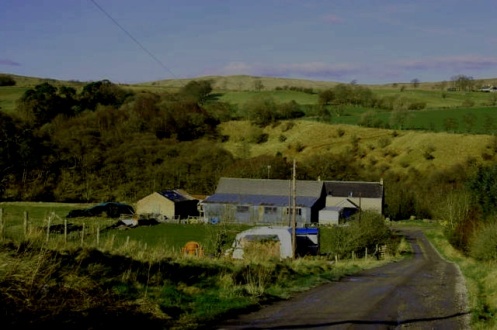 Mid Heilar © Bob Forrest and licensed for reuse.
Mid Heilar © Bob Forrest and licensed for reuse.
(17.) The ‘John Gibsone in Dalgaine’ who appears on both the bond and the joint testimony was probably the John Gibson ‘in Mid-hillar’ in Sorn parish found on the Fugitive Roll. Dalgain was another name for the parish of Sorn. (Jardine, ‘United Societies’, II, 210.)
Map of Mid Heilar Street View of Entry to Mid Heilar
(18.) John Edward ‘in Dalgaine’, i.e., in Sorn parish, appears on both bond and the joint testimony. He was not listed not the Fugitive Roll.
 Keirshill © Mary and Angus Hogg and licensed for reuse.
Keirshill © Mary and Angus Hogg and licensed for reuse.
(19.) Adam Allan ‘in Dalmellingtoun’ who appears on both the bond and the joint testimony was probably the Adam Allan ‘in Keirhill’ in Dalmellington parish who was listed on the Fugitive Roll (Jardine, ‘United Societies’, II, 205.)
Keirshill is marked on the nineteenth century OS maps up the hill from Keirs.
Map of Keirshill Aerial View of Keirshill
Street View of turn off to Keirshill
The Three Society People Not On The Bond
Little is known about the three Society people who subscribed the joint testimony but were not listed on the bond.
(20.) The name of Matthew Machan is only known for the subscription list of the joint testimony.
(21.) Hugh Simm, whose name appears on the subscription list of the testimony between those of John Sime and William Sime. was the brother of John and William. Hugh lived at Damhead in Eaglesham parish.
It is not clear if Hugh Syme was banished to Carolina, as he was mentioned in Mrs Dunlop’s letter of September, 1686. (See above.) It is possible that Syme was either not banished after taking oaths, or was banished and returned.
(22.) John Alexander, who subscribed the joint testimony, is said to have died of thirst at the end of the voyage. (Wodrow, History, IV, 10.)
The Banished Prisoners Who Did Not Subscribe The Joint Testimony
The first four prisoners listed on the bond did not subscribe the joint testimony.
(23.) The name of John Nisbett, ‘wool finer in Glasgow’, does not appear on the Fugitive Roll.
(24.) Adam Hodgeon ‘in Dowglass’ was almost certainly the ‘Adam Hodgean in Douglas’, Douglas parish, Lanarkshire, listed on the published Fugitive Roll of May, 1684. (Jardine, ‘United Societies’, II, 196.)
The two other nonsubcribers of the joint testimony are of considerable interest for the history of the Society people.
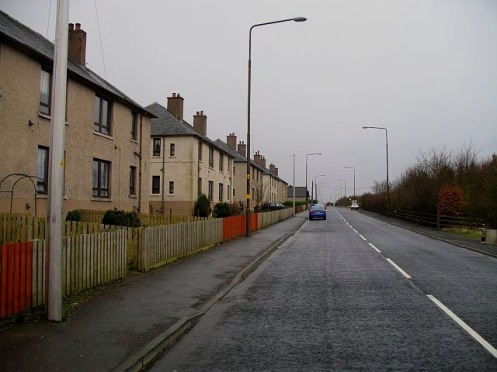 Breich © Richard Webb and licensed for reuse.
Breich © Richard Webb and licensed for reuse.
(25.) John Dick ‘alias Kid in Livingstoune’ was almost certainly John Dick ‘son to William Dick in Brerich’, i.e., Breich in Livingston parish, Linlithgowshire, who appears on the Fugitive Roll. (Jardine, ‘United Societies’, II, 213.)
Map of Briech Street View of Breich
According to Wodrow, ‘In November [1683], John Richmond was taken by major [John] Balfour [in Glasgow], and died publicly next year.
That same night, John Dick and John Williamson were taken; the first was banished to Carolina, John Williamson made some compliances, for which he showed evident repentance, and was after the revolution [of 1688-90] a minister of this church [i.e., the Church of Scotland].’ (Wodrow, History, III, 496.)
The capture of John Dick and John Williamson together was probably not a coincidence. Dick and Williamson were both students, or ‘expectants’ for the ministry, for the United Societies who were taught in secret, initially by John Binning of Dalvennan and later by Thomas Linning. (Shields, FCD, 66.)
Wodrow held letters of Dick from April and June, 1684, which detailed his interrogations. To some extent Dick agreed to his own banishment.
‘I have likewise some original letters of John Dick, dated April and June this year [i.e., 1684], with his interrogatories without date; but I take them to have been in April, at Glasgow. He was in June banished to Carolina. Some of his interrogatories and answers deserve a room here, he being a very sensible knowing person.
“Being asked, if it was lawful to bear arms, answered, he thought it lawful for the defence of religion, that is, when people are oppressed for adhering to their principles, pressed to deny them, and killed for not denying them, and for personal defence against robbers and murderers.
He was further asked, but what if the king should carry on a course contrary to the word of God, may he be opposed by arms? he answered, he might, when no other means could prevail. The bishop, or professor of divinity, he does not mind which, said, But I’ll make it plain to you from the word of God, that though the king carry on a course contrary to scripture, he ought not to be opposed. John interrupting him, said, the world will never do that, for it is a setting scripture against itself, and the like of it was never heard.
Then it was asked, if he would kill one of the king’s guards if he found them in the way. He answered, he was of no such murdering principles.
They were very close upon him, as to his praying for the king; and after many questions this way, they asked. Can you now pray for him; he said, I can as he hath a soul, and hath not sinned the unpardonable sin, but to pray for him as he is king, and for the prosperity of his courses, I cannot do.”
He notices the bishop, with a great deal of pains and cunning, essayed to bring him to some acknowledgment that might have been matter of libel, but he endeavoured to bear off.
In his original letters, he excuses their entering into terms with Walter Gibson for transportation, and expresses his doubts, how far they were obliged to propale their principles, when they could not be proven against them, and whether silence or shifting were not lawful without making compliances, and presses sobriety, which he complains there is but little of, and peremptoriness against all sin.’ (Wodrow, History, IV, 9; John Dick, covenanter banished to Carolina, copies of papers of (1684)’, NLS. MSS. Wod.Qu.XXXVI, f194.)
John Williamson was not banished. He was probably the minister of Cranstoun parish between 1694 and 1712. He died aged sixty-five in 1720. In 1684, Williamson would have been around twenty-nine years old. (Fasti, I, 310.)
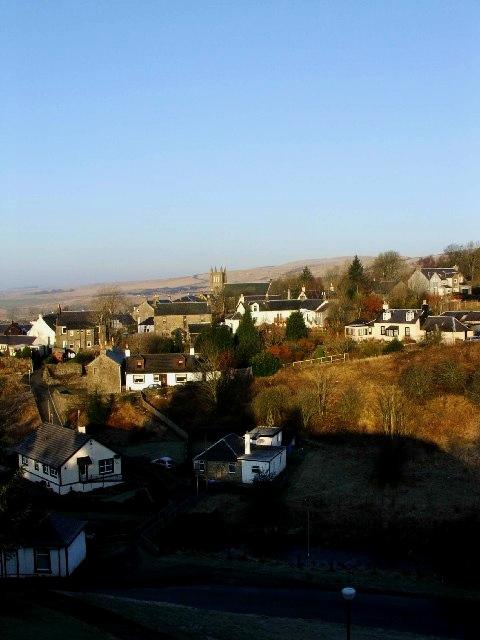 Dalmellington © Mark Klimek and licensed for reuse.
Dalmellington © Mark Klimek and licensed for reuse.
‘Gilbert McAdam in Dalmellingtoun’ returned from banishment was was killed in June, 1685. He belonged to the Waterhead MacAdam family in Carsphairn parish, which had property in Dalmellington.
According to Wodrow, he was the son-in-law of ‘James Dun of Bluewhat’, i.e., Benquhat/Benwhat in Dalmellington parish. Through his wife, Gilbert was brother-in-law to Robert Dun, who was killed at Caldons in January, 1685.
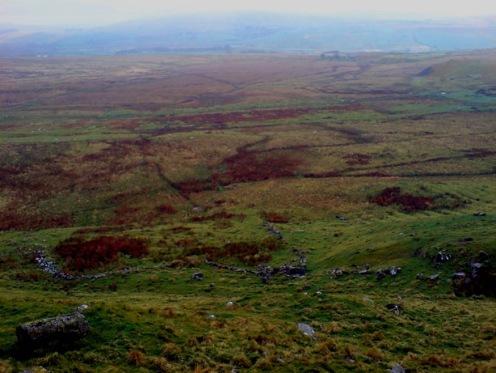 Benquhat © david johnston and licensed for reuse.
Benquhat © david johnston and licensed for reuse.
Today, Benwhat is primarily remembered as a lost mining village. The village war memorial survives and is sited just above the ruins of Benquhat farm on Benquhat Hill.
Map of Benwhat Aerial View of Benwhat
According to Wodrow, Macadam was taken prisoner in 1682 for not attending church. At Dumfries he was released on a bond of £400 Scots posted by his father-in-law, James Dun in Benquhat. Macadam failed to appear when summoned by the court and the bond was forfeited. Soon after he was seized and taken to Glasgow where he refused the oath of Allegiance and was banished to the plantations on Gibson’s ship in 1684. His father advanced £20 Sterling to Carolina to purchase him out of his indenture and he returned to Scotland in early 1685. (Wodrow, History, IV, 329.)
He was shot in the fields during the Killing Times of 1685.
James Renwick preached against the banishments near Greenock.
Text © Copyright Dr Mark Jardine. All Rights Reserved.



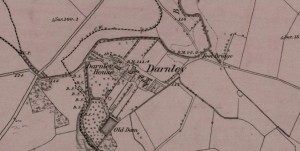

[…] after the Carolina Merchant banishments, James Renwick preached at Greenock and ‘near Paisley’. The both preachings almost certainly […]
James Renwick’s Preaching ‘Near Paisley’ in 1684 « Jardine's Book of Martyrs said this on December 6, 2012 at 12:12 am |
[…] that as a failing and subscribed a joint testimony in support of the Societies’ cause when he was banished in July, 1684. Leading moderate presbyterians involved in the Carolina Scheme facilitated his […]
James Algie and John Park, and the Society People in Eastwood Parish « Jardine's Book of Martyrs said this on December 7, 2012 at 2:47 pm |
[…] His son, who was also named John Buchanan, was banished to Carolina in 1684. […]
From Glasgow to Barbados: A Preaching in Renfrewshire in January 1687 « Jardine's Book of Martyrs said this on January 11, 2013 at 2:45 am |
[…] In 1684, his brother, John ‘at Egilshame’, had probably been banished to Carolina. […]
The Banishment of Andrew Young in Eaglesham to Barbados in 1687 « Jardine's Book of Martyrs said this on January 24, 2013 at 7:28 am |
[…] A Robert Urie, also of Little Govan, was banished to Carolina in 1684. […]
The Polmadie Martyrs: Major Balfour, Shoots Three Covenanters Near Glasgow « Jardine's Book of Martyrs said this on February 14, 2013 at 1:17 am |
[…] Black was banished to Carolina soon after Nisbet’s execution. […]
The Execution in Glasgow of James Nisbet in Highside: ‘Put Him Off and Be Damned’ « Jardine's Book of Martyrs said this on February 18, 2013 at 5:31 pm |
[…] father was captured, probably at some point after the publication of the Fugitive Roll, and banished to Carolina at the Glasgow circuit court in mid June. Their father subscribed a joint testimony of twenty-two Society people which was commended by […]
The ‘Levelling Fury’ of William Young in Strathaven | Jardine's Book of Martyrs said this on June 26, 2013 at 8:17 am |
[…] The prisoners allegedly attacked by the Devil were probably many of the prisoners held in Glasgow Tolbooth in June, 1684, who were banished to Carolina. […]
The Devil Attacks in Glasgow in 1684 | Jardine's Book of Martyrs said this on August 17, 2014 at 2:26 pm |
[…] terms as a desertion of the testimony in Scotland. At the same time as the Malloch banishments, several Society people held in Glasgow offered a joint testimony against their banishment and those who accepted voluntary exile to Carolina. James Renwick, the Societies’ minister, also […]
The Life of Alexander Reid, Covenanter. in Uphall | Jardine's Book of Martyrs said this on October 15, 2014 at 3:08 pm |
[…] was settled, the provost, Walter Gibson, (who had been chosen by the arch bishop [and been involved in banishing Society people in 1684]) made a paction with the presbyterians, (for preventing confusion) that the keyes of all the […]
The Great Snowball Tumult at Glasgow Cathedral in 1689 #History #Scotland | Jardine's Book of Martyrs said this on May 9, 2016 at 6:03 pm |
[…] Robert Dun’s brother-in-law and his sister’s husband, Gilbert MacAdam ‘in Dalmellington’, had been banished to the plantations in 1684, but he returned and was later killed escaping from a house in June, […]
The Covenanter Assassins at Caldons in January, 1685 #History #Scotland | Jardine's Book of Martyrs said this on November 18, 2018 at 6:19 pm |
[…] of those on the “Carolina Merchant” can be identified. They included Robert Urie who may have been known to the contingent from the Little Govan area. A […]
James Renwick’s Preaching at Greenock and the Carolina Merchant Banishments | Jardine's Book of Martyrs said this on November 22, 2018 at 6:00 pm |
Excellent
D Green said this on July 24, 2020 at 7:10 pm |